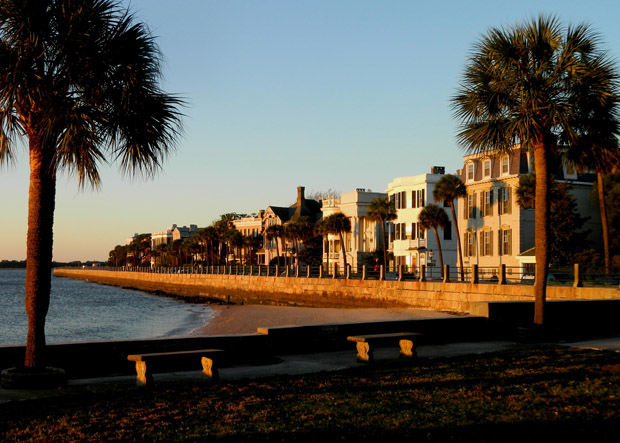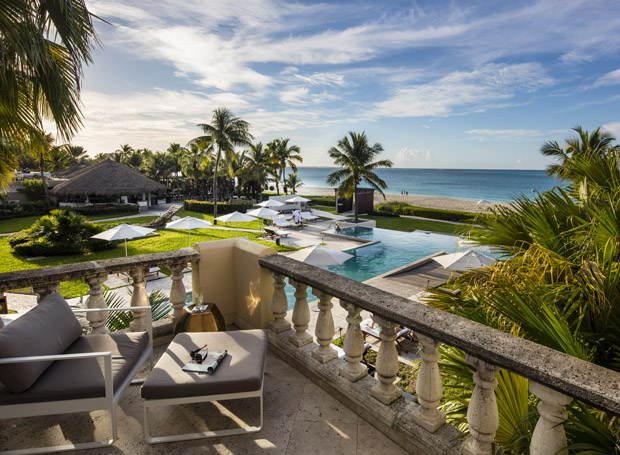The Wall That Built Our History
06 Mar 2017
Pillars of such beauty, the High Battery and White Point Gardens have a history as colorful and vibrant as the homes that still stand there. From fortresses to saltwater bathing houses, follow the journey from the creation of the iconic wall to today.
By SUZANNAH SMITH MILES

Of all the beautiful places in our city, no place says “Charleston” more stunningly than the Battery. With its expansive harbor views, elegant mansions and the tree-shaded park called White Point Gardens, the site is a matchless combination of natural beauty and history.
The Battery is, in many ways, the true heart of the city. Here one sees the two rivers converge, the Ashley River meeting the Cooper. And while the result may not be as momentous as the native Charlestonian’s belief that the two rivers joined to form the Atlantic Ocean, the historical events which occurred in and around those waters is undeniable. As the late Charleston artist Elizabeth O’Neill Verner wrote of the harbor in her book, Mellowed By Time, “What a world of heroism that narrow channel has witnessed… Fort Moultrie on one side and Fort Sumter on the other, and yet between those two a gap was once so wide that it split a nation.”
Indeed, it was from the High Battery promenade that Charlestonians gathered on the morning of April 12, 1861, to watch the firing on Fort Sumter and the beginning of the American Civil War. Today, the huge cannons of that conflict are part of the monumental landscape of White Point Gardens, silent reminders of the site’s military importance.
Before Charles Town was founded, this lower end of the peninsula was mostly lowland marshes and creeks. The most distinguishing characteristic was a spit of sun-bleached oyster shells jutting into the river at the very end, giving rise to the place named “Oyster Point,” and later, “White Point.”
The first change to this natural landscape dates back to the early 1700s, and marks the beginning of what we know today as High Battery. This was when Charles Town was a walled city and, to protect the southeastern side, an earthen work dike with fortifications was built along the harbor front. Granville Bastion stood at the upper end, generally in the area where the Carolina Yacht Club is today. The Middle Bastion (first known as Lytlleton’s and as Fort Darrell and Fort Mechanic during the Revolutionary War) was midway down the dike. Broughton’s Battery (also Fort Wilkins during the Revolutionary War) was erected at the southernmost point.
During the ensuing years, as the city grew, defenses were strengthened and when breaches were caused by hurricanes, this seawall became more substantial. It was when the wall was refortified during the War of 1812, that the area became generally known as “the Battery.” The sea wall promenade we know today was started in the early 1850s and, like its forebears, strengthened again in the late 1880s and 1890s after hurricanes.
It was during the peaceful period between 1820 and 1860 that most of the grand mansions fronting East Battery were erected. One of the earliest was the Regency-style Edmonston-Alston House at 21 East Battery. It was erected in 1817 and is still open today as a museum house operated by the Historic Charleston Foundation. The yellow-stuccoed Louis B. DeSaussure mansion at 1 East Battery was a relative late-comer, erected in 1858. It received a number of hits by Union shells during the Civil War, and one is purportedly still lodged in an attic beam. The yellow brick mansion at 19 East Battery is the newest. When it was erected in 1920 it was touted as one of the most expensive homes ever built in Charleston. It replaced an earlier mansion owned by the Holmes family and was built atop the ruins of the Middle Bastion. Later, it had to be razed after the hurricane of 1911. During World War II, the mansion was used as offices by the U.S. Navy.
In 1837, the city set aside seven acres at the foot of King Street for the public park known as White Point Gardens. From the outset, the park was planned as a place to be enjoyed by all people from all walks of life, not only for the wealthy who resided in the mansions overlooking its green spaces.
Besides trees, walkways and harbor views, a main draw was the saltwater bathing house, basically a floating structure in the Ashley River which surrounded an enclosed pool of river water. Touting “capacious private bathing rooms lighted by Venetian windows” with a “large swimming bath in the center,” it was a welcome respite for Charlestonians during the hot summer months. Patrons could pay by visit, but its popularity was such that entire families purchased season subscriptions. The facilities included separate bathing areas for men and women, promenades, sitting areas, a bar for men and an ice cream “saloon” for ladies. People would gather to enjoy the view from its piazzas, watch fireworks and enjoy musicales. During the Civil War, the roof of the bathing house was used as an observatory by the Confederate Signal Service.
During the Civil War, the park once again became an armed fortification and the tree-lined walkways were replaced by massive Confederate earthworks mounted with heavy guns and cannons, some of which are the same ones seen in the park today. Known first as White Point Battery, it was later named Battery Ramsay to honor Major David Ramsay of the Charleston Battalion, who was killed on Morris Island in 1863.
The park was rebuilt after the war and today, the guns are quiet except for the happy screams of glee coming from children climbing on top of them. The most noticeable reminder of the war is the monumental bronze statue at the southeastern corner of the park, its figures facing east towards Fort Sumter, dedicated to the Confederate Defenders of Charleston, erected in 1932.
Of the many monuments in the park, most are military-related and all represent a part of Charleston’s history. The 20-feet tall Hobson Monument, a modified, modern obelisk at the foot of King Street, was erected to honor the men of the U.S. destroyer Hobson. It was originally built at the Charleston Navy Yard and accidentally sunk in a collision on April 26, 1952. The stones around the base represent the 38 home states of the 176 sailors who died when the Hobson sank.
One of the newest monuments in the park is the statue honoring General William Moultrie, who commanded the patriots during the Battle of Fort Sullivan on June 28, 1776. With only 400 men in a half-finished fort built of palmetto logs, Moultrie’s men routed the British fleet attempting to take Charleston and the fort was later named Fort Moultrie in his honor. The statue was sculpted by local sculptor John Ney Michel and, appropriately, unveiled on Carolina Day, June 28, 2007, the 231st anniversary of that victory.
One of the most popular wedding venues in Charleston today is the gazebo-like bandstand, erected in 1911 for musicals and concerts. And for the children there is the water fountain called the Dancing Girl, a gift to the city in 1962 by the celebrated Charleston sculptor Willard Hirsch, and purposely mounted with a low base to make it easy for children to use.
“The city belongs personally to every one of us,” wrote Elizabeth O’Neill Verner. There is no place that bears more truth to her statement than the Battery and White Point Gardens. Whether a first time visitor or a native who grew up playing amongst the cannons, we all share a love for this remarkable place of beauty and history.











